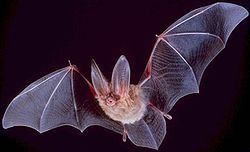- Microbat
-
Microbats 
Townsend's Big-eared Bat, Corynorhinus townsendii Scientific classification Kingdom: Animalia Phylum: Chordata Class: Mammalia Order: Chiroptera Suborder: Microchiroptera
Dobson, 1875Superfamilies Emballonuroidea
Rhinopomatoidea
Rhinolophoidea
Vespertilionoidea
Molossoidea
Nataloidea
NoctilionoideaThe microbats constitute the suborder Microchiroptera within the order Chiroptera (bats). They are most often referred to by their scientific name. Other English names are "insectivorous bats", "echolocating bats", "small bats" or "true bats". All these names are somewhat inaccurate, because not all microbats feed on insects, and some of them are larger than small megabats.
The distinctions between microbats and megabats are:
- Microbats use echolocation, whereas megabats do not typically (The Egyptian fruit bat Rousettus egyptiacus is an exception).
- Microbats lack the claw at the second toe of the forelimb.
- The ears of microbats do not close to form a ring: the edges are separated from each other at the base of the ear.
- Microbats lack underfur; they have only guard hairs, or are naked.
Most microbats feed on insects. Some of the larger species hunt birds, lizards, frogs or even fish. Microbats that feed on the blood of large mammals (vampire bats) exist in the Americas south of the United States. Microbats are 4 to 16 cm long. [1] Leaf-Nosed Microbats are also known to be fruit and nector-eating. Three species Leaf-Nosed Bats follow the bloom of columnar cacti in Northwest Mexico and Southwest United States northward in the spring and then the blooming Agaves southward in the fall.[2]
Contents
Echolocation
Microbats generate ultrasound via the larynx and emit the sound through the nose or the open mouth. Microbat
 calls (help·info) range in frequency from 14,000 to over 100,000 hertz, well beyond the range of the human ear (typical human hearing range is considered to be from 20Hz to 20,000 Hz). The emitted vocalizations form a broad beam of sound that is used to probe the environment. See the main article on animal echolocation for details.
calls (help·info) range in frequency from 14,000 to over 100,000 hertz, well beyond the range of the human ear (typical human hearing range is considered to be from 20Hz to 20,000 Hz). The emitted vocalizations form a broad beam of sound that is used to probe the environment. See the main article on animal echolocation for details.Some moths have developed a protection against bats. They are able to hear the bat's ultrasounds and flee as soon as they notice these sounds, or stop beating their wings for a period of time to deprive the bat of the characteristic echo signature of moving wings which it may home in on. To counteract this, the bat may cease producing the ultrasound bursts as it nears its prey, and thus avoid detection.
Classification
This is the classification according to Simmons and Geisler (1998):
Superfamily Emballonuroidea
- Family Emballonuridae (sac-winged bats or sheath-tailed bats)
Superfamily Rhinopomatoidea
- Family Rhinopomatidae (mouse-tailed bats)
- Family Craseonycteridae (Bumblebee Bat or Kitti's Hog-nosed Bat)
Superfamily Rhinolophoidea
- Family Rhinolophidae (horseshoe bats)
- Family Nycteridae (hollow-faced bats or slit-faced bats)
- Family Megadermatidae (false vampires)
Superfamily Vespertilionoidea
- Family Vespertilionidae (vesper bats or evening bats)
Superfamily Molossoidea
- Family Molossidae (free-tailed bats)
- Family Antrozoidae (pallid bats)
Superfamily Nataloidea
- Family Natalidae (funnel-eared bats)
- Family Myzopodidae (sucker-footed bats)
- Family Thyropteridae (disk-winged bats)
- Family Furipteridae (smoky bats)
Superfamily Noctilionoidea
- Family Noctilionidae (bulldog bats or fisherman bats)
- Family Mystacinidae (New Zealand short-tailed bats)
- Family Mormoopidae (ghost-faced bats or moustached bats)
- Family Phyllostomidae (leaf-nosed bats)
References
External links
- Bat World Sanctuary
- Illustrated Identification key to the bats of Europe (see "Recent publications")
- Bat Conservation International
- Bat flight realtime simulation
Categories:- Bats
Wikimedia Foundation. 2010.
